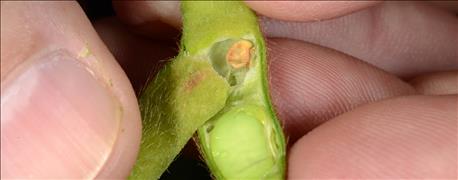
Crop consultants, whether independent or working through your local retail supplier, sometimes schedule scouting trips at various points in the season. To save a few bucks, you might be tempted to call off late-season scouting. Could insects even cause economic damage that late?
The Indiana Certified Crops Adviser panel tackles this dilemma. Panel members are Jamie Bultemeier, agronomist with A&L Great Lakes Labs in Fort Wayne; Gene Flaningam, Flaningam Ag Consulting LLC, Vincennes; and Bryan Overstreet, Extension ag educator in Jasper County.

KEEP WATCHING INSECTS: Insects deserve watching in soybeans, even if it means hiring a scout to monitor them for you. This damage was caused by brown stinkbugs. Bean leaf beetles can also feed on pods before harvest. (Photo courtesy of John Obermeyer, Purdue University Extension)
Bultemeier: Foliar feeding on soybeans can reduce photosynthesis capabilities during early grain fill. Insects can also impact grain quality if they feed on pods during late grain fill. Bean leaf beetle defoliation in August can be treated. It can have a large enough impact on yield to justify treatment.
Flaningam: August is an ideal time to inspect soybeans for several insects, including bean leaf beetles, stinkbugs and other insects that may feed on pods. Inspect soybean fields for signs of pod feeding during the reproductive stage, which begins soon, if it hasn’t already.
Overstreet: Bean leaf beetles have a second generation in mid- to late summer. According to the Purdue University Corn & Soybean Field Guide, the threshold that justifies treatment at the full seed or R6 stage is anything over 25% defoliation with beetles actively feeding, or 5% to 10% damage to pods with 10 or more beetles per foot of row. (When determining percent defoliation or percent feeding, take the whole plant into consideration.)
Flaningam: Inspect two soybean plants in five different areas of the field. Count the number of pods per plant, and determine what percentage of pods overall show signs of feeding. Note if pods are still green, or if they are already turning yellow and maturing. That is a factor in determining possible payoff for a proposed insecticide application. If you find 10% of the pods with feeding damage, and if plants are still green and developing, then an insecticide treatment may be justified.
Overstreet: If you or your consultant finds enough damage to meet the threshold triggering treatment, consult Purdue Extension Publication E-77 on soybean insect control recommendations for 2016. You can find it at edustore.purdue.edu.
About the Author(s)
You May Also Like




